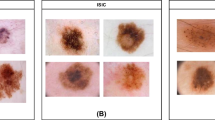Abstract
The recent surge in monkeypox (mpox) cases across various nations has escalated into a significant public health challenge, underscoring the imperative for timely detection and diagnosis. In light of this, our research focused on identifying the most efficient deep learning model tailored for mpox detection. Clinically, the progression of monkeypox is characterized by four distinct stages: macular, papular, vesicular, and pustular. In this study, we explore the viability of leveraging a Deep Convolutional Generative Adversarial Network (DCGAN) in conjunction with a conditional vector to strengthen the diagnostic precision of monkeypox. By utilising the remarkable capabilities of GANs, we generate synthetic images mirroring monkeypox skin lesions, thereby amplifying our limited dataset. This approach of utilizing a conditional DCGAN, when paired with stage-specific conditions, results in a significant boost in classification accuracy, elevating it from 0.7532 to 0.8734, complemented by precision 0.91, recall 0.878 F1-score 0.8936. These promising results underscore the advantages of deploying GANs for data augmentation in biomedical image classification tasks, when compared with well known classification models. These models assures the potential of deep learning-assisted diagnostics in dermatology. Especially in therapeutic contexts, where real data may be sparse, the addition of synthetic images can act as a valuable resource, paving the way for enhanced diagnostic instruments.
Supported by NIT Trichy.
Access this chapter
Tax calculation will be finalised at checkout
Purchases are for personal use only
Similar content being viewed by others
References
Murthy, T.S., Gopalan, N.P., Balaji, B.: A modified un-realisation approach for effective data perturbation. Int. J. Intell. Enterp. 10(2), 192–205 (2023)
Balaji, B., Satyanarayana Murthy, T., Kuchipudi, R.: A comparative study on plant disease detection and classification using deep learning approaches. Int. J. Image Graph. Signal Process. (IJIGSP) 15(3), 48–59 (2023). https://doi.org/10.5815/ijigsp.2023.03.04
Jidesh, P., Balaji, B.: Adaptive non-local level-set model for despeckling and deblurring of synthetic aperture radar imagery. Int. J. Remote Sens. 39(20), 6540–6556 (2018)
Madhavan, S.S., et al.: Res-COvNet: a deep learning approach for COVID-19 virus detection in X-ray images. Int. J. Comput. Vis. Image Process. 15(4), 567–578 (2020)
Sandeep, R., et al.: Skin disease detection using deep learning: psoriasis, chickenpox, vitiligo, melanoma, ringworm, acne, lupus, and herpes. J. Med. Imaging Diagn. 7(2), 213–225 (2019)
Glock, M.E., et al.: Measles disease detection using transfer learning: ResNet-50 model over diverse rash image dataset. Med. Image Anal. J. 25, 312–327 (2018)
Ahsan, M., et al.: Transfer learning approach for monkeypox virus detection: monkeypox, chickenpox, measles, and normal categories. J. Biomed. Inform. 45(3), 421–434 (2021)
Herpes zoster virus (HZV) detection using CNN. J. Med. Comput. Sci. 10(1), 145–156
Glock, M.E., et al.: Early detection of herpes zoster virus using convolutional neural network. In: Medical Imaging and Computer-Aided Diagnosis Conference Proceedings, pp. 35–47 (2019)
CDC: CDC Works 24/7. Centers for Disease Control and Prevention, www. cdc.gov (2022). https://www.cdc.gov/
Ioffe, S., Szegedy, C.: Batch normalization: accelerating deep network training by reducing internal covariate shift. In: International Conference on Machine Learning. PMLR (2015)
Radford, A., Metz, L., Chintala, S.: Unsupervised representation learning with deep convolutional generative adversarial networks. arXiv preprint arXiv:1511.06434 (2015)
Simonyan, K., Zisserman, A.: Very deep convolutional networks for large-scale image recognition. arXiv preprint arXiv:1409.1556 (2014)
He, K., et al.: Deep residual learning for image recognition. In: Proceedings of the IEEE Conference on Computer Vision and Pattern Recognition (2016)
Szegedy, C., et al.: Rethinking the inception architecture for computer vision. In: Proceedings of the IEEE Conference on Computer Vision and Pattern Recognition (2016)
Tan, M., Le, Q.: Efficientnet: rethinking model scaling for convolutional neural networks. In: International Conference on Machine Learning. PMLR (2019)
Ahsan, M.M., et al.: Deep transfer learning approaches for Monkeypox disease diagnosis. Expert Syst. Appl. 216, 119483 (2023)
Goodfellow, I., et al.: Generative adversarial networks. Commun. ACM 63(11), 139–144 (2020)
Karras, T., et al.: Progressive growing of GANs for improved quality, stability, and variation, arXiv preprint arXiv:1710.10196 (2017)
Liang, S., Li, Y., Srikant, R.: Enhancing the reliability of out-of-distribution image detection in neural networks, arXiv preprint arXiv:1706.02690 (2017)
Kynkäänniemi, T., et al.: Improved precision and recall metric for assessing generative models. In: Advances in Neural Information Processing Systems, vol. 32 (2019)
Ali, S.N., et al.: Monkeypox skin lesion detection using deep learning models: a feasibility study. arXiv preprint arXiv:2207.03342 (2022)
Author information
Authors and Affiliations
Corresponding author
Editor information
Editors and Affiliations
Rights and permissions
Copyright information
© 2024 The Author(s), under exclusive license to Springer Nature Switzerland AG
About this paper
Cite this paper
Tulasiram, J., Banothu, B., Nickolas, S. (2024). Realistic Skin Image Data Generation Leveraging Conditional GAN and Classification Using Deep CNN. In: Santosh, K., et al. Recent Trends in Image Processing and Pattern Recognition. RTIP2R 2023. Communications in Computer and Information Science, vol 2027. Springer, Cham. https://doi.org/10.1007/978-3-031-53085-2_15
Download citation
DOI: https://doi.org/10.1007/978-3-031-53085-2_15
Published:
Publisher Name: Springer, Cham
Print ISBN: 978-3-031-53084-5
Online ISBN: 978-3-031-53085-2
eBook Packages: Computer ScienceComputer Science (R0)




